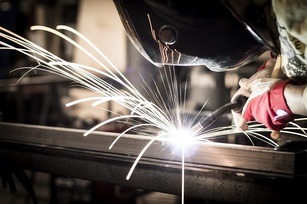Call: 708-425-9080
Top 20 Issues To Consider So That Your Aluminum Welding Project Will Run Smoothly

|
We do quite a bit of Aluminum welding at Meyer Tool. Welding Aluminum can be extremely challenging. If you do not properly account for the many variables that go into a welding project there can be performance issues in addition to unnecessarily increasing the cost and lead time for your project. We have taken some time to go through our list of the top 20 variables that need to be considered when getting your project ready for fabrication.
|
#01 - Is This ASME Code Work?
Adding an ASME code requirement to a welding project has many residual effects. Additional paperwork is required in order to provide documented trace-ability to materials used on the job. Additional independent AI, (Authorized Inspector), steps are required at certain milestones of the fabrication process in order to ensure that the fabrication is performed to code requirements. Only certain welders are allowed to perform work on ASME code projects. In general, there is more paperwork and more oversight which adds cost to the project when the project must meet ASME code.
#02 - What Material Specifications Need To Be Met?
Knowing the exact base material designation is very important when planning out an Aluminum welding project. The selection of the base material opens the door to a select group of filler material options. Different combinations of base material alloys and filler material alloys react during the welding process to produce variations in the final weld strength and composition.
#03 - Are There Any Cosmetic Requirements?
Cosmetic requirements would include secondary surface finish treatments such as anodizing. Any highly polished surface finish requirements are also considered cosmetic in nature. Cosmetic requirements will affect the type of filler material that is used for the job. Depending on the base material, there are certain filler materials that will blend in better with the base metal while other fillers will show a sharp contrast to the base metal after polishing or anodizing operations are complete.
#04 - How Thick Is The Material Being Welded?
Material thickness can play a big role in determining the welding plan for a project. The thicker samples have more of a heat sink effect which makes controlling starts and stops more challenging. This difficulty is amplified in cases where pre-heating of the work piece is either not possible or not allowed due applicable weld procedures and assembly configurations.
#05 - Are There Any Performance Test Criteria That Need To Be Met?
Welds for pressure and vacuum service have a much higher criteria for acceptance when it comes to both performance and cosmetic requirements. It is important to understand the exact performance criteria for the welding project so that the welding plan will meet your design expectations without underperforming or making you pay for a level of quality that you do not need. Dye penetration tests, CWI inspections, and x-ray evaluations are common performance test criteria integrated into project plans to ensure that certain level of quality is maintained.
#06 - What Type Of Joint Preparation Is Required?
Certain types of joint preparations are easier to produce compared to others. Some weld preps can be done by hand while others require additional machining operations. Over-specifying a joint prep can add unnecessary time and cost into the fabrication process. Calling out full penetration welds unnecessarily not only adds to the prep and weld time but could also add to the fixturing and straightening time associated with dealing with the additional heat that is being entered into the part.
#07 - What Fabrication Tolerances Need To Be Met?
A tolerance can mean the difference between a 20 minute weld and 2 day machine/weld project. If there is extra material on the parts or if there are machining operations down the line then tolerances can be relaxed for the welding operations which greatly reduce setup time and increases throughput.
#08 - Are There Any CWI Inspection Requirements?
CWI inspections are opportunities for checkpoints during the welding projects to ensure the welding work is adequate and consistent. However, there is a trade-off since performing periodic inspections can slow down progress if there is waiting being done to obtain approval to move onto the next weld operation. Meyer Tool has a certified CWI on staff which allows for frequent progress checks ensuring that the project progresses without interruption.
#09 - Is There Any Special Fixturing Required?
Fixturing has a tendency to be an afterthought during the planning stages of the project, however, a little time spent upfront can save a lot of frustration and rework down the road. At Meyer Tool, we commonly fabricate unique, complicated assemblies. Many times orientation for various components is critical. It is a best practice to put some time into thinking through your fixturing requirements before it comes time to weld. By thinking through the orientation and accessibility requirements for the assembly ahead of time you can have your fixtures fabricated and ready to go when it comes time to weld. This ensures that the project stays on track and on budget without unexpected delays or fixturing expenses at crunch time.
#10 - Are Forming Templates Required?
Sometimes it is extremely beneficial to have forming templates available in order to check for proper geometry and fit-up. Forming templates can take some of the guess work out of interpreting complex drawing packages. Forming templates also act as a quality inspection step as they represent a go/no-go gauge when it comes to proper assembly orientation.
#11 - Are All Welding Symbols Clearly Called Out On Drawings?
This may seem like an obvious check, but more often than not we will run into drawings that are missing the required weld call-outs. Errors and mistakes happen when information is not clearly stated on fabrication drawings. It is not safe to assume that all welds shown on a drawing are to be fabricated to the same call-out requirements. At Meyer Tool we spend extra time re-checking all fabrication prints to ensure that the necessary weld information is present on the drawings. Weld symbols are checked per specification AWS 2.4:2012.
#12 - Are All Drawings Legible?
In many cases fabrication drawings are created on a computer under the ideal conditions of an office environment. Viewing the fabrication prints in a shop environment is a different story. It is not uncommon to have copies and mark-ups included on fabrication prints. It is extremely important to review all prints and ensure that all dimensions and notes are legible and large enough so that they can be easily viewed and interpreted by fabrication staff. The best solution is to consider these circumstances when the drawings are first being generated and ensure that the drawings are formatted for large paper sizes, "D" size is preferred.
#13 - Are All Welding Symbols Consistent Across Drawings?
On complicated assembly drawings it is not uncommon to occasionally see conflicting weld symbol call-outs for the same part on different views in the assembly drawing package. At Meyer Tool we take extra steps to check for weld call-out consistently. To prevent errors it does not hurt to take a second pass through the drawing package to check for such inconsistencies before the work hits the shop floor. If a part shows up multiple times in a drawing package the weld symbols should be the same in every instance.
#14 - Are Practice Pieces Required?
Sometimes additional material and fabrication time needs to be incorporated into the project plan. Additional samples may be needed if a new WPS has to be qualified. Another reason for weld samples would be for use dialing in weld parameters on various pieces of equipment such as seam welders, positioners, and other welding machines.
#15 - Are Backup Strips Required?
Backup strips must be accounted for so that material can be made available. In certain instances the use of backup strips is not possible due to fit-up issues. It is a good practice to at least stop and think about the need for backup strips so that you can have them available to keep the project progressing smoothly.
#16 - Are Runoff Tabs Required?
Run-off tabs need to be accounted for from both a time and material perspective when shell seam welding is required. Run-off tabs are added to provide additional material for the start and finish of the welds. The start and finish of a weld is prone to inconsistencies. Adding the tabs allow for the inconsistencies to occur in sacrificial material instead of on the product.
#17 - Has The Design Been Reviewed To Use As Much MIG Welds As Possible And Are The Welds As Small In Size As Possible?
The majority of the welding we do at Meyer Tool is TIG. However, the use of MIG welds can reduce welding time and thereby reduce cost. Unnecessarily large weld call-outs are also a good area to reduce cost and lead time. On a large assembly the time it takes to lay down a beefy weld on a small part can add up pretty quick if there are a couple of dozen of those small parts in the assembly. Be aware of non-critical welds and reduce your weld specifications accordingly so that the fabrication quality meets the quality level for the project. Excessive quality will unnecessarily add cost to your project.
#18 - Is There An Existing Weld Procedure Or Must a New Procedure Be Qualified?
Qualifying a new weld procedure can be tricky depending on the performance requirement of the WPS. Aerospace grade welding specifications can include different classes that breakdown the level of acceptable defects. In some cases, destructive testing may be required in order to verify that the mechanical strength of the weld stays within a certain range based on the weld procedure. It is most beneficial if there is existing WPS documentation that can be followed. At Meyer Tool, we have a wide range of WPS documents that cover a variety of materials and welding processes. We also have the capability to qualify new procedures as needed.
#19 - Is Destructive Testing Required?
Destructive testing adds another level of scrutiny to weld performance evaluation. It is entirely possible for a weld to pass dye penetration and x-ray tests and yet fail a mechanical strength test. There are many variables that go into determining the final mechanical strength of a weld including cleanliness, filler material, base material, filler-to-base material interactions, weld speed, heat input, material thickness, sample size, and many, many, more. Passing a destructive test checking for mechanical strength performance can be extremely challenging and frustrating at times. It is important to allocate time and resources in your project schedule to account for the need to make variations in your weld procedure in order to pass the test requirements. Testing adds to total lead time of the project. At least 4 weeks can be added to the project schedule if parts need to be sent out for evaluation.
#20 - How Are You Going To Keep It Clean?
Cleanliness is critical when it comes to Aluminum welding. Removing oxide layers from both sample and filler material is important to achieving a consistent weld. Dirt and grime can be extremely detrimental to Aluminum welds due to the presence of hydrocarbons. The introduction of Hydrogen during the weld process can lead to cracking and other non-conformance conditions. Grinding media used to clean and prepare surfaces can also lead to contamination since most media contains aluminum-oxides. It is of paramount importance to segregate materials, minimize oxidation, and wire bush areas to maintain a clean environment.



